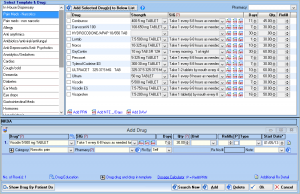EMR software is no longer an option – it is a necessity for improving patient outcomes, boosting productivity and reducing costs. The problem for smaller surgery centers, however, is that many surgery-specific EMR systems are designed for use in hospital settings and include features and workflows suited to larger organizations. Because of this, surgery centers often find themselves in a difficult position when selecting an Surgery Center EMR.
The good news is that there are suitable options available, including EMR systems like 1st Providers Choice, which can help surgery centers meet the health care triple aim and focus on preoperative, intraoperative and postoperative care.
If your surgery center hasn’t implemented EMR software yet, here are three reasons why you should:
1. Improve efficiency in the OR.
EMR software can significantly improve efficiency in all areas of your business, specifically the operating room. For example, instead of manually entering data into the EMR from different surgical monitors and devices, the software can be integrated so that data values are captured instantly and saved into the patient’s chart in real-time. The ability to use pre-loaded templates for specific surgeries and procedures also saves time, as it eliminates the need to enter standard data.
2. Enhance patient safety and care.
Surgery Center EMR software has the potential to improve care quality and treatment outcomes by providing physicians with detailed surgery reports that can reveal insightful trends. For example, you may choose to run a report on all patients who had a specific surgery and were seen after two days for a post-op and another for those who had the same surgery but were seen after five days. Comparing the results, you can determine whether it makes a difference to follow-up with patients sooner after surgery.
A well-designed EMR system can also alert users of important fields that need to be completed in the patient’s chart, ensuring that all critical data is entered at the point of care. Plus, it will notify you of things that could pose harm to the patient (e.g. drug-drug or drug-allergy interactions).
More importantly, the EMR ensures that all notes are completed before you can move forward, so that no important data is missed. This means that the intra-operative section cannot be opened until all pre-op notes have been entered and signed off on – and the same goes for discharge and post-op.
3. Increase staff satisfaction.
Implementing EMR software can be overwhelming for physicians and staff, as it forces new ways of doing things. Even though the new ways of working may be better, change is hard; so it is beneficial to choose software that minimizes disruptions and simplifies otherwise burdensome tasks. For example, EMR software that makes it easy for authorized users to access health records, billing and appointment information from anywhere is a definite must. With surgeons increasingly depending on their iPhones and iPads for instant access to all kinds of medical information, mobile EMR software is an automatic win with staff.
Additionally, because Surgery Center EMR software offers different functionalities for different users, it becomes easier for staff to understand their specific roles. All you have to do once the software is implemented is make sure that each person understands his or her role and what they are responsible for inputting in the EMR.
To learn more about our EMR solution for surgery centers, call 480-782-1116 or contact us online.











